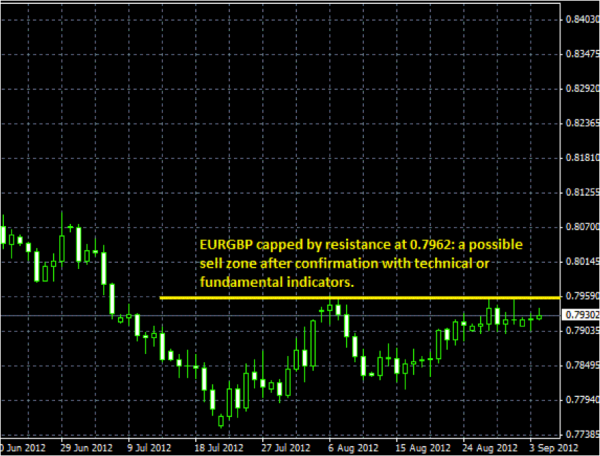EURGBP
The EURGBP used to be typically range-bound, but as the differential in the level of affectation of the Eurozone and the British economy became clearer, the bias for the currency pair shifted solidly in the GBP’s favour.
Today, not much has changed. The Eurozone is still battling with sovereign debt problems and the attendant bailouts that the ECB has had to provide to cushion the effects on the affected economies. The UK has its own problems too, but these are generally more manageable than those of the Eurozone. Given the fact that the EU is the UK’s largest trade partner, the EURGBP is a currency pair that will throw up trading opportunities regularly.
So what’s the outlook for this pair? Look at the daily chart of the EURGBP below.

We can clearly see that the price action is inching towards the 0.7962 level, which is a resistance level that has held firmly since August 6th and has been tested five times without breaking down. This is a reflection of the situation with the Euro, in which for many months now, market optimism on the Euro has waned. Even comments by the top echelon of the ECB only produce transient relief for the single currency and traders go a-selling after a very short Euro rally.
So with these facts in view, there is really nothing to expect other than a Euro stall at that resistance level, before a renewed round of selling takes it all the way down once more. However, this trade should not be taken hook, line and sinker. Rather, the trader should do the following:
1) Watch the markets for anything that will give the Euro a real lift at that resistance level. This will only occur if for instance, we have some very strong positive news such as the ECB actively surprising the markets by buying Eurobonds.
2) In the absence of any positives for the Euro, the only way to go after price action gets to 0.7962 is down. Such a move will continue until we get to the nearest support at 0.7785. Get a confirmatory signal before selling at the resistance. Such signals would come in the form of more negative Euro news (fundamental), or a technical signal coming from a bearish reversal candlestick or an indicator showing overbought conditions, or a combination of both.
The expected bearish move would be about 180 pips, which should be enough to satisfy a trader while looking for other opportunities elsewhere. You can find more on this at Investing.co.uk.
AUD
Here’s a quick note about the AUD here. Two key news releases are scheduled for Tuesday and Wednesday: the GDP q/q (9.30pm EST on Tuesday) and the employment data (9.30pm on Wednesday). Economists are predicting figures that will be worse than the previous figures. The AUD is one currency that responds in an unambiguous manner to news releases, so traders can actually trade the news as it concerns the Aussie.
The key to trading the news is to watch out for the deviation of the actual figures from the consensus figures, especially if such a deviation is to the upside. If the news releases surprise to the upside, it will also confirm the falling wedge signal that is presently in formation for the AUDUSD. This will then produce a good upside break that will last about 200 pips over the next few days.
What sets the tone for news trades is the degree of deviation. The greater the deviation of the actual news figures from the consensus, the larger the movement. Deviation is measured in terms of how far the consensus is from the previous figure. The actual figure then has to top this figure to produce a trading signal.



